The Storm Skiing Podcast #6 | Download this episode on iTunes, Google Podcasts, Stitcher, TuneIn,and Pocket Casts | Read the full overview at skiing.substack.com.
Who: Stephen Kircher, Boyne Resorts President and CEO
Why I interviewed him: Because it’s worth remembering, in our hey-let’s-cash-out-and-sell-grandpa’s-ropetow-to-Vail-or-Alterra moment, that not only are family-owned mountains still a dogged and powerful presence in North American skiing, but one of the big four ski companies is itself family owned. The story of how the Kircher family built and sustained one of the world’s great ski empires over the past seven decades offers sound lessons in resilience, evolution, and the power of continuous, gradual change. There is no reason why a 500-vertical-foot ski hill lodged in the remote North of Michigan’s Lower Peninsula should have spawned a nine-resort, coast-to-coast mountain kingdom, but relentless innovation in chairlift configurations, snowmaking technology, grooming, and basic business operations did exactly that. With this operating philosophy, Boyne has weathered every financial crash, snow drought, on-mountain fad, and swing in consumer tastes for more than 70 years, and now stands as a low-key driver of ski industry innovation, a model of sustainable business in a rough industry, and a load-bearing wall of the Ikon Pass’ 41-resort network. How Boyne did this and continues to do it is a story I wanted to hear.
What we talked about: Why Boyne leased a bunch of its mountains and then bought them back last year, in addition to four others; the sense of stewardship Stephen feels in running a business that his father built into a giant; how Boyne flipped the script and became the David that devoured Goliaths; the importance of the humble Gatlinburg Sky Lift – a scenic triple chair crawling up Crockett Mountain in Tennessee – in funding the Kircher’s empire-building; you won’t believe the western mountains Boyne passed on buying when it bought Big Sky in the ‘70s; Everett Kircher as a swashbuckling pioneer-pilot scouting the company’s growth via airborne adventures; how Boyne avoided the mistakes of both American Skiing Company and Intrawest; what they learned from refugees of those companies that now run important parts of Boyne; how Les Otten’s vision teed up key industry developments; the Max Pass; keeping the Max band together when Alterra formed; why there’s no Boyne pass; Ikon growing pains at Big Sky; how Air B&B is scrambling the human and business ecosystems of mountain towns; why Boyne welcomes Vail to the Northeast and how the company has benefitted every single time Vail has devoured a nearby mountain, including Canyons and Whistler; why even rich people hate Vail; how Boyne is, um, blowing everyone away in the snowmaking game; how Boyne eliminated boilerplate in the Midwest and why Stephen thinks they can do the same in the Northeast; add water bars to that endangered species list; how Boyne can get away with waiting until it’s 22 degrees to blow snow in most cases and why they do that; Sunday River versus Killington and the annual race to first in the Northeast; why you may one day see Sugarloaf enter that race; Sunday River’s plans to build a ninth mountain and the resort’s ongoing glading, snowmaking improvements, and lift upgrades; what Boyne did with $460 million; no they won’t buy more resorts, but maybe they’d manage one if the right partner came along; why they built Brackett Basin at Sugarloaf as a giant glade and guess what we might see a T-bar back there one day; why we’ll never see another top-to-bottom gondola on Sugarloaf; what we might see instead; Stephen skis all over the world and you will want to hear where his top five ski days over the past several years have been; Boyne’s decades-long leadership in chairlift innovation; why high-speed quads are on the verge of elimination; what the new high-speed lift standard will be; we’ll see more eight-packs where they make sense; the massive footprint of the Ramcharger 8; Big Sky’s 2025 development plan; the planned replacement of the Big Sky tram and yes it will have a bigger box
Things that may be slightly outdated because we recorded this a while ago: Stephen and I talked at the end of August, so the company’s plans to replace Loon’s Kancamagus detachable quad with the continent’s second eight-seater had not yet become public. When I asked him if Ramcharger 8 was a one-off or if we can expect more of these, he said we could, but did not specify where, which is understandable because these things can be held up for any number of permitting or contract reasons.
Question I wish I’d asked: So many. I had a whole line of questioning about Loon, and we never touched it. We could have spent another hour each on Sunday River or Sugarloaf or Big Sky and gotten into the specifics of the lift upgrades and terrain expansions he touched on. I really wanted to ask about the now-dead Wasatch Interconnect and Boyne’s part in that negotiation via Brighton. Boyne had just days before our interview announced a broad implementation of RFID after being one of the last notable bastions of my beloved wicket tickets, and we intended to discuss this and just didn’t have time. The Boyne empire is so vast and his knowledge so deep that I could probably interview Stephen for an hour every week for the rest of the season and never run out of things to talk about. But when you can get an hour with a guy like that, you have to pick the most important things and even then the conversation takes unmapped roads and there’s just a lot that has to be left for next time.
What I got wrong: I said early on that Boyne didn’t “answer to investors” like Alterra, but clearly the company does have investors, as even a cursory search of its credit history will show. The company also didn’t “buy back” all of the mountains that it had been leasing from Oz Real Estate last year – it had owned some of them previously and purchased four of them for the first time. I also said that KSL and Intrawest “merged” to form Alterra, but KSL and Henry Crown, which owns Aspen, actually jointly purchased Intrawest and, after buying Mammoth and Deer Valley, formed Alterra, which both companies jointly own (this is not the first time I’ve flubbed this, and the convoluted and many-layered ownership structure is getting annoying enough to talk about that I wish the company would just go public so I can stop having to research this every time I mention it). Also I don’t know where I read that another Sugarloaf gondola was imminent, but Stephen made it clear that this was never going to happen.
Why I thought that now was a good time for this interview: Because the more its larger cousins eat the ski world, the more important it will be to have Boyne as a relatively impervious counterweight that can keep Alterra honest. I don’t know if Alterra needs Boyne more or if it’s the other way around, but one has lasted a whole hell of a long time without the other, and if I’m making last-man-standing bets among the big four of Powdr, Vail, Alterra, and Boyne, I’m choosing Boyne, and I don’t have to think very hard about it. Plus they will keep pushing technology and terrain expansion and every other part of the skier experience in a way that will force their peers to do the same, and that’s good for all of us that love this sport.
Why you should go there: Because if you like rad mountains, they have them. Sunday River and Sugarloaf are not only the two best mountains in Maine, they are inarguably top 10 in the region. The somewhat awkwardly named Summit at Snoqualmie in Washington State is actually a cobbled together collective of four separate ski areas, one of which is the unquestionably rad Alpental. Cypress provides a nice, less frantic alternative to Whistler. Boyne Mountain and Highlands are two of the best kept and most diverse mountains in Michigan, and probably the top two if you remove Mt. Bohemia, which is sort of a freak occurrence in the state, like those videos of Kyrie Irving decked out as 70-year-old Uncle Drew and dunking on playground bozos. And of course Big Sky is one of those reasons you keep skiing after you wear out the local nub and the mountains all around you start to look small and you daydream about the West and make lists during work meetings of places you must visit and honestly it’s one of the only places that won’t get you laughed off of the internet when it’s used to fill in the blank in this question, “So, I’m thinking about a trip to Jackson Hole or __________* and I’m wondering which you’d recommend?”
* Examples of mob-acceptable alternatives to Big Sky include but are not limited to Squaw Valley, Snowbird, or Whistler. Examples of mountains that will invite howling ridicule include Park City, Heavenly, or Keystone - all fine mountains (and I’m not picking on Vail), but not in the League of Radness with Jackson Hole. Don’t get mad - I didn’t make these rules. I’m just telling you what they are.
The Storm Skiing Podcast is on iTunes, Google Podcasts, Stitcher, TuneIn, and Pocket Casts. The Storm Skiing Journal publishes podcasts and other editorial content throughout the ski season. To receive new posts as soon as they are published, sign up for The Storm Skiing Journal Newsletter at skiing.substack.com. Follow The Storm Skiing Journal on Facebook and Twitter.
Check out previous podcasts: Killington GM Mike Solimano | Plattekill owners Danielle and Laszlo Vajtay| New England Lost Ski Areas Project Founder Jeremy Davis | Magic Mountain President Geoff Hatheway | Lift Blog Founder Peter Landsman








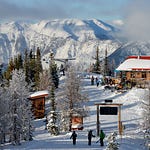

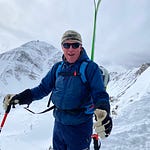
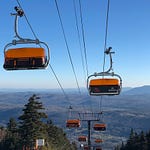
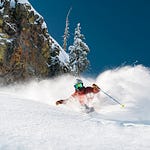
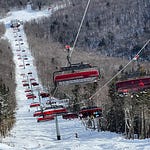
Podcast #6: Boyne Resorts CEO Stephen Kircher